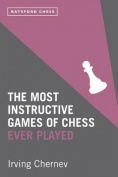 The Most Instructive
Games of Chess Ever Played by Irving Chernev
2014
Batsford
Ltd,
London
The Most Instructive
Games of Chess Ever Played by Irving Chernev
2014
Batsford
Ltd,
London
http://www.Batsford.com
312 pages
Price $23.95
ISBN 978-1-84994-161-7
Pleasant to mention is this revised edition with updated
algebraic format of Chernev’s super read of his 1960 master work: The
Most Instructive Games of Chess Ever played.
This work features 62 best games of all time played by the best players
of all time as Botvinnik,Capablanca,Tarrasch,Fischer,Alekhine,Lasker
and Petrosian.
Bobby Fischer must have been very proud in 1960 to see two of his best
played game in this book where Chernev, compares Bobby Fischer with the
great chess genius Paul Morphy.
{Fischer’s restless energy in attack}
Fischer,Robert James - Berliner,Hans Jack [B03]
USA-ch (Rosenwald 7th) New York (5), 23.12.1960
1.e4 Nf6 2.e5 Nd5 3.d4 d6 4.c4 Nb6 5.exd6 cxd6 6.Nc3 g6 7.Bd3 Bg7
8.Nge2 Nc6 9.Be3 0-0 10.0-0 e5 11.d5 Ne7 12.b3 Nd7 13.Ne4 Nf5 14.Bg5 f6
15.Bd2 Nc5 16.Nxc5 dxc5 17.Bxf5 Bxf5 18.f4 exf4 19.Nxf4 Qd6 20.Nh5 Rae8
21.Nxg7 Kxg7 22.Bf4 Qd7 23.Qd2 Rf7 24.Bh6+ Kg8 25.Rae1 Rfe7 26.Rxe7
Qxe7 27.h3 Qe4 28.Qf2 Qe7 29.g4 Bd3 30.Rd1 Be4 31.d6 Qe5 32.Bf4 Qc3
33.d7 Rd8 34.Qe2 Qf3 35.Qxf3 Bxf3 36.Bc7 1-0.
Berliner is mentioned in "How I Started To Write", an essay by Carlos
Fuentes, where he is described as "an extremely brilliant boy", with "a
brilliant mathematical mind"
Later he became world champion in correspondence chess,
As no other Irving Chernev had the talent to explain the basic strategy
of winning as we for example, can see in the following game from
Emanuel Lasker where every move is a threat!
Lasker was a tough man to beat because he made use of ideas in his
games years before they were discovered by the Hypermoderns.
Porges,Moritz - Lasker,Emanuel [C67] Nuremberg Nuremberg (1), 20.07.1896
1.e4 e5 2.Nf3 Nc6 3.Bb5 Nf6 4.0-0 Nxe4 5.d4 Be7 6.Qe2 Nd6 7.Bxc6 bxc6
8.dxe5 Nb7 9.b3 0-0 10.Bb2 d5 11.exd6 cxd6 12.Nbd2 Re8 13.Rfe1 Bd7
14.Ne4 d5 15.Ned2 Ba3 16.Be5 f6 17.Qa6 fxe5 18.Qxa3 e4 19.Nd4 Qf6 20.c3
Rf8 21.f3 Qg5 22.Qc1 Nc5 23.Nf1 Qg6 24.Re3 Nd3 25.Qd1 Nf4 26.Ng3 h5
27.Nde2 Nxg2 28.Kxg2 exf3+ 29.Rxf3 Bh3+ 30.Kxh3 Qg4+ 31.Kg2 Qxf3+
32.Kg1 h4 33.Nh1 Qe3+ 0-1.
Chernev writes: Here for example he demonstrates the Nimzowitsch
concept that a restriced position is not necessarily disadvantageous.
What counts is the amount of pent-up energy in the position, and the
possibility of this energy exploding.
Conclusion: One of those classic works that you must have read!
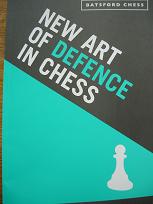
New Art of Defence
in Chess by Andrew Soltis
2014
Batsford
Ltd,
London
http://www.Batsford.com
232 pages
Price $23.95
ISBN 978-1-84994-160-0
Andrew Soltis comes with a impressive update of his 1974 work,The Art
of Defence in Chess.
As we can learn from Soltis in this well written manual, a lot of
things in chess have changed in these 30 years.
For example in 1974 the position after the moves Naiditsch,Arkadij
(2574) - Svidler,Peter (2727) [B42] Dortmund Gr-A Dortmund (5),
26.07.2004
1.e4 c5 2.Nf3 e6 3.d4 cxd4 4.Nxd4 a6 5.Bd3 Bc5 6.Nb3 Be7 7.0-0 d6 8.c4
Nf6 9.Nc3 Nbd7 10.f4 Qc7 11.Qe2 b6 12.Bd2 Bb7 13.Rae1 0-0 14.Kh1 g6
15.Nd4 Rfe8 16.Nf3 Rad8 17.Ng5 Bf8 18.Qf2 Bg7 19.b4 Nh5 20.Rc1 Rc8
21.a3 Qd8 22.Nf3 Rc7 23.Rfe1 Nhf6 24.Qh4,Soltis writes: In 1974,the
year I wrote The Art of Defence in Chess,this would have been
considered a favourable position for white, a plus over equals
advantage at least.
But today most masters would prefer to play black, Practically
after 24…Qa8!
As we can in this book from Soltis you don’t have to be a great
calculator to be a good defender, you just need the right tools and
this book is overloaded with it.
Super interesting is the section Prophylaxis and Counterplay.Aaron
Nimzowitsch elaborated on the use of prophylaxis in the 1920s.
As we can learn from Soltis:However,the emphasis then and for the
decades to come was on safety for the sake of safety.It was the ounce
of prevention to void needing a pound of cure.
Prophylaxis was considered an alternative to counter play.
New Defence changes the focus:Prophylaxis can be the necessary
preparation for counter play
A amassing game is Klavins,Janis - Zhdanov,Igor [B15]
LAT-ch 18th Riga (3), 1961
1.e4 c6 2.Nc3 d5 3.Nf3 g6 4.d4 Bg7 5.h3 a6 6.Bf4 Nf6 7.e5 Ng8 8.Qd2 b5
9.Be2 h6 10.0-0-0 e6 11.g4 Nd7 12.Bg3 Bf8 13.Rdf1 Nb6 14.Nd1 a5 15.Ne1
b4 16.Nd3 Nc4 17.Qe1 Qb6 18.b3 Qxd4 19.bxc4 Qa1+ 20.Kd2 dxc4 21.Nf4
Qxa2 22.Ke3 Bb7 23.Qd2 g5 24.Nh5 c3 25.Qd3 Rd8 26.Qe4 Bc5+ 27.Kf3 Rd4
28.Qe3 Qd5+ 0-1.
Yes it is black who delivered mate!
Conclusion: A impressive update!
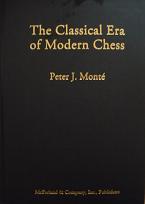
The Classical Era of Modern Chess by Peter J.Monte
2014
McFarland &
Company,Inc.,Publishers Box 611
Jefferson,North Carolina 28640.
http://www.mcfarlandpub.com
594pages
Price $65,00
ISBN
978-0-7864-6688-7
The modern Era began with Botvinnik and the rise of the Soviets but the
chess researcher here means the new rules of chess, which began slowly
evolving from the less dynamic
shatranj version into the
modern play of the game.
As we can read all
shatranj players
were divided into five of six classes.A game was turned into victory by
the rather unusual checkmate,by the more common
stripping away of all the King’s forces [bare king] or by stalemate.
The birth of modern chess began in the 12th and 13th centuries.
Peter J.Monte examines the classical era of what became modern chess
from the late 15th century into the 1640s
This all comes with a excellent coverage of relevant chess
literature witch includes works by von der Lasa, van der Linde,
Murray, Chicco,
Eales, Petzold, Sanvito, and Garzón—and chronicles all opening
and game moves of the era and the development of laws and modern
rules,which we
still use today.
This all comes with a glossary and more than over 100 eye catching
illustrations.
The author describes in great detail historical works as from
Lucena’s,Göttingen manuscript,work from Damiano,German
Manuscript,Ruy Lopez,Urbinate Manuscript,The
“Elegance”Manuscripts,Printed Works of the Lopez-Complex,Annibale
Romei,Polerio’s Boncompagno,Polerio’s Leon Manuscript,Rotilio Gracco
etc.
Interesting to mention is part two of this work with a small 100 page
coverage of openings and games of the classical Era of Modern Chess.
Here you will find romantic openings as the Latvian Gambit {Greco
Gambit},King’s Gambit,Italian Game etc.
Part two is a major presentation of all opening variations and games
recorded by the classical authors.
But first some practical examples:
Polerio,Giulio Cesare - Leonardo,Giovanni da Cutro [C40] Rome
Rome, 1572
1.e4 e5 2.Nf3 f5 3.Nxe5 Qe7 4.Qh5+ g6 5.Nxg6 Qxe4+ 6.Kd1 Nf6 7.Qh4 Ng4
8.d3 hxg6 9.Qxh8 Nxf2+ 10.Kd2 Qg4
11.Qe5+ Kf7 12.Be2 Qg5+ 13.Kc3 Qh4 0-1,
Eck - Von Heydebrand und der Lasa,Tassilo [C41]
Berlin m4 Berlin, 10.09.1837
1.e4 e5 2.Nf3 d6 3.Bc4 f5 4.Bxg8 Rxg8 5.exf5 Bxf5 6.h3 g5 7.g4 Be6 8.d3
h6 9.Be3 Bg7 10.c3 Rf8 11.Nbd2 Bd5
12.Rh2 Qf6 13.Ng1 b5 14.f3 c5 15.c4 bxc4 16.dxc4 Bc6 17.Rf2 Na6 18.Nb3
Ba4 19.Qc2 Nb4 20.Qc3 e4 21.Qxf6 Bxf6
22.Rd2 Bxb2 23.Rb1 Bc3 0-1,
Kings Gambit: Greco,Gioacchino - NN [C37]
Europe Europe, 1620
1.e4 e5 2.f4 exf4 3.Nf3 g5 4.Bc4 g4 5.Ne5 Qh4+ 6.Kf1 Nf6 7.Bxf7+ Kd8
8.d4 Nxe4 9.Qe2 Ng3+ 10.hxg3 Qxh1+
11.Kf2 fxg3+ 12.Kxg3 Qxc1 13.Nc6+ Nxc6 14.Qe8# 1-0.
6….Nf6 is called the Santa Maria Defence in Italy in view of Salvio’s
remark.
1.f4 f5 2.d4 d5 3.Nf3 c5 4.c3 e6 5.e3 a6 6.g3 c4 7.b3 b5 8.a4 Bb7
9.axb5 axb5 10.Rxa8 Bxa8 11.b4 Nc6 12.Bd2 Bd6
13.h4 Nf6 14.Ng5 Qc8 15.Bh3 h6 16.Nf3 Ne4,yes even the good old Bird’s
Opening was popular those days.
Included are Appendix of Problem Sections, Concordance of the Lucens
Complex, Concordance of the Lopez-Complex, Concordance of
the Polerio Complex and a unbelievable bibliography.
Conclusion: Certainly one of the best written chess books of all time!
 TrainingMiddlegameFritztrainer
TrainingMiddlegameFritztrainer
Mating Patterns
by Maurice Ashley
2014
http://www.chessbase.com
E-Mail info@chessbase.com
Price Euro 27.90
ISBN: 978-3-86681-425-7
Pentium-Processor at 300 Mhz or higher, 64 MB RAM, Windows XP, Windows
Vista, Windows 7, DVD drive, mouse, soundcard
The well known chess trainer Grandmaster Maurice Ashley provides the
beginning chess student with all kind of useful mating patterns, as for
example mating
on diagonals,or bank rank mates.
This highly instructive material is a must basis for all who like to
understand the basics of chess understanding.
I found on this 30 carefully selected tactical video feedback examples
that are good for around 4 hours video entertiment.
Conclusion: Excellent material to
leans the basics of chess understanding!
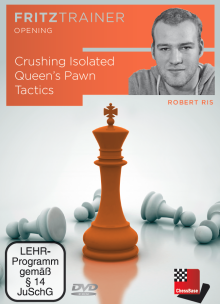
TrainingOpeningFriztrainer
Crushing Isolated Queen’s Pawn Tactics
by Robert Ris
2014
http://www.chessbase.com
E-Mail info@chessbase.com
Price Euro 29.90
ISBN: 978-3-86681-425-7
Pentium-Processor at 300 Mhz or higher, 64 MB RAM, Windows XP, Windows
Vista, Windows 7, DVD drive, mouse, soundcard
The well known chess crack Grandmaster Robert Ris digs here in the
world of the Isolated Queen’s Pawn,all explained at the hand of 33
carefull selected video files where the user is specially invited to
explore the tactical prospects of the Isolated queen’s Pawn.
Some times it arises from different move orders as from the good old
Caro-Kann as we can see in the following model game: Kaidanov,Gregory S
(2420) - Anand,Viswanathan (2500) [D42]Moscow-B Moscow, 1987
[Ris,Robert]
1.e4 c6 2.d4 d5 3.exd5 cxd5 4.c4 Nc6 5.cxd5 Qxd5 6.Nf3 e6 7.Nc3 Qd8
8.Bd3 Nf6 9.0-0 Be7 10.a3 0-0 11.Re1 b6 12.Bc2 Ba6 13.b4 Bc4 14.b5 Na5
15.Ne5 Rc8 16.Re3 Rc7 17.Rg3 Re8 18.Bh6 Bf8 19.Bg5 Be7 20.Bxf6 Bxf6
21.Bxh7+ Kxh7 22.Qh5+ Kg8 23.Ne4 Bd5 24.Rh3 24...Kf8? [24...g6 25.Nxg6
fxg6 26.Qxg6+ Bg7 27.Ng5 Kf8 28.Nh7+ Kg8 29.Ng5 (29.Re1) 29...Kf8]
25.Qxf7+! [25.Qxf7+ Rxf7 26.Ng6+ Kg8 27.Rh8#] 1-0.
Included is an extra database of 64 entries where I found several games
with excellent annotations as for example:
Bacrot,Etienne (2710) - Edouard,Romain (2587) [D27]
FRA-chA 86th Caen (9), 23.08.2011
[Edouard,R]
A very important game for both players. I was half a point behind
Maxime Vachier-Lagrave, who was leading, and I had good chances to
finish with a very good place if I did not lose that game. Etienne was
half a point behind me and absolutely had to win.
1.d4 d5 2.Nf3 Nf6 3.c4 dxc4 4.e3 e6 5.Bxc4 a6 6.0-0 c5 7.Bb3!? The main
variation. 7...Nc6 8.Nc3 cxd4 [8...Be7 9.dxc5 is well-known as a
slightly worse position for Black.] 9.exd4 Be7 10.Bg5 0-0 11.Qd2 Bd7!?
A new idea in a line with a bad reputation. We found it in the games of
Andrei Istratescu, who used it for the first time in 2010, against
Caruana, but lost after miscalculating one line.
12.Rad1 [12.Rfe1!? Rc8 (12...Na5? 13.Bc2 Nc4 14.Qf4 Nxb2 15.Qh4 h6
16.Bxh6 gxh6 17.Qxh6 followed by ¦e5+-.) 13.Rad1 Na5 14.d5!? A
straight line in order to try to refute Black's conception. 14...Nxb3
15.axb3 h6? (15...exd5! was the right choice, but after 16.Rxe7 Qxe7
17.Nxd5 Qd8 18.Bxf6 gxf6 Andrei missed that 19.Qh6 fails to 19...Rc6! .
Thanks to this defence, Black is just very fine.) 16.Bxh6! gxh6
17.d6² 1-0 Caruana,F (2675)-Istratescu,A (2615)/SUI 2010 (42)]
12...Na5 13.Bc2 Nc4 14.Qe2!? A very interesting idea that I had
forgotten to look at. [14.Qf4 Nxb2 15.Qh4 is critical.] 14...Rc8
[14...Nxb2 was critical, and probably best, but I was not sure about
the position after 15.Rc1! since Black has problems regarding his
knight on b2. For instance: (15.Rb1? Rc8) 15...Rc8 (15...Bc6!? 16.Rb1
Qa5; 15...Qa5!?) 16.Ne5 b5 17.Ne4! with pressure.] 15.Bb3!? A very
high-class move, in my opinion. Black's knight cannot go back to a5.
15...b5 [15...Na5? 16.d5! exd5 (16...Nxb3?! 17.d6± .Na5 18.dxe7
Qxe7 19.Nd5!) 17.Bxd5 is unpleasant.;
15...Nb6 was probably best, but I couldn't work out if my pawn was
better placed on b7 or b5!] 16.Ne5 Nb6 [16...Nxe5 17.dxe5 Nd5 18.Bxd5
Bxg5 19.Bb7±] 17.Rfe1 h6!? A very interesting decision. I felt
that 17...b4 was unpleasant for Black. I thought including ...h6
¥h4 would not help much. However, that move leaves the ¥xh6
possibility, which is clearly critical. But after calculating it, we
both had 15 minutes on the clock, and I felt like ¥xh6 was quite
unclear. And actually, I thought "Ok, I must be mistaken, my position
looks ugly after 18.¥xh6". Still I believed my opponent would need
to spend time on it, and the game would become very unclear. [17...b4
18.d5! (18.Bxf6!? Bxf6 19.Ne4 Bb5 20.Qg4 is unpleasant for Black.)
18...exd5T (18...bxc3? 19.dxe6+-) 19.Nxd7 (19.Bxf6 Bxf6 20.Nxd5 Nxd5
21.Rxd5 Bxe5 22.Rxe5 Bb5 and Black should hold.) 19...Qxd7 20.Qxe7 Qxe7
21.Rxe7 bxc3 22.Bxf6 gxf6 23.bxc3 Rxc3 24.Ra7 and Black will suffer
forever.] 18.Bxh6!? Ok my plan only half worked: Etienne played it
instantly. However, I was happy that he didn't go ¥h4. [18.Bh4 was
best in my opinion. Black has some problems.;
18.Bxf6 Bxf6 19.Bc2 (19.Ne4 Bc6 20.Nxf7 Rxf7 21.Bxe6 Bd5 is definitely
OK for Black.) 19...Be8 followed by ...g6 and ...¥g7 seems OK to
me.] 18...gxh6 [18...b4? 19.d5+-] 19.Rd3!? [19.d5 exd5 20.Nxd7 Qxd7
21.Qxe7 Qxe7 22.Rxe7 Rfd8 and I believe Black equalises due to
...¤c4 which is coming.] 19...Kh8 [19...b4? Actually I played
19...¢h8 instantly, as a move like 19...b4 is not very human-like.
However, it does not look so simple: 20.Qd2 Kh7 21.Rh3 Ng8 22.Ne4! f5
23.Nc5! Bxc5 24.dxc5 Nd5 25.Bxd5 exd5 26.Qxb4 with very huge
compensation, but I am not sure Black is worse.] 20.Qd2!? An
interesting option in time trouble. [Objectively 20.d5 should be best:
20...exd5 21.Nxd7 Qxd7 (21...Nbxd7!? 22.Qxe7 Nc5) 22.Qxe7 Qxe7 23.Rxe7
Rfe8 24.Rxe8+ Rxe8 25.Kf1 and White is slighly better thanks to the
pawn structure, but I believe Black should hold. However, it was clear
Etienne wanted to take advantage of the time trouble in order to mate
me. He managed to do so, by the way!] 20...Ng8 21.d5 Nc4 [21...exd5!?
22.Nxd5 Nc4 was another option to defend, which I missed (Ok, let's
admit it's ugly). However, Black seems to hold: 23.Qc3 (23.Nxc4 bxc4
24.Bxc4 Bg5!! and Black is fine. A completely computer-like defence.)
23...Nxe5 24.Qxe5+ Bf6T 25.Nxf6 Nxf6 26.Red1 (26.Rxd7 Qxd7 27.Qxf6+ Kh7
followed by ...¦c6 and Black is fine.) 26...Re8 27.Rxd7 Qxd7
28.Qxf6+ Kh7=] 22.Bxc4 bxc4 23.Rd4 Bc5?? A tremendous blunder! Time was
short, and that move seemed obvious to me. I missed that after 24.dxe6
¥xd4 25.£xd4 ¥xe6 (attacking White's queen), ¤xf7
was double check!! [23...Qe8 was of course the only move: 24.Nxd7
(Etienne told me he was intending to play 24.Nxc4 but after 24...Bb5!?
I feel like Black is very fine. White should have enough counterplay
for a draw, but certainly nothing more.) 24...Qxd7 25.dxe6 and I
believe I should escape without big problems: 25...Qc6 26.Nd5 c3!
(taking the c3-square from White's queen) 27.bxc3 Bg5 28.f4 Bf6 with
unclear position.] 24.dxe6 Bxd4 25.Qxd4 Qf6 [25...Bxe6 26.Nxf7++- Oops
!] 26.exd7 Rcd8 27.Re3 Ne7 28.Rf3 Nc6 29.Nxf7+ 1-0
Video running time: 5 h 29 min (In the English langauge)
Conclusion: Super material!
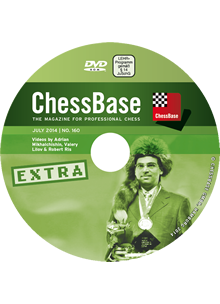
ChessBase Magazine
extra issue 160 Extra
July 2014
Videos by Adrian Mikhalchishin,Valeri Lilov & Robert
Ris
ChessBase
http://www.chessbase.com
E-Mail
info@chessbase.com
ISSN 1432-8992
Euro 12.99
This well loaded issue is good for 34894 entries and all played
between April and June of this year.
The most loaded comes from the World champion Blitz, good for over the
1000 entries.
By the way this great event was won by the great Magnus!
In these ChessBase Magazine you will find games from professionals en
strong amateurs as the following Latvian Game,that shows the power of
suprice!
Privara,Igor (2271) - Kleman,Miroslav (2218) [C40]
Bratislava Slovan op Bratislava (5), 29.04.2014
1.e4 e5 2.Nf3 f5 3.Nxe5 Nf6 4.exf5 Qe7 5.Qe2 d6 6.Nf3 Nc6 7.Qxe7+ Bxe7
8.Bb5 Bxf5 9.Nd4 Bd7 10.Bxc6 bxc6 11.0-0 c5 12.Nf3 Bg4 13.Re1 Bxf3
14.gxf3 Kd7 15.Nc3 Rhf8 16.d3 Nh5 17.Kg2 Rf5 18.Ne4 Raf8 19.Ng3 Nf4+
20.Bxf4 Rxf4 21.Re3 Bg5 22.Ne4 Bh6 23.Nd2 Rb4 24.b3 Bxe3 25.fxe3 Rh4
26.f4 Rg4+ 27.Kf3 Rg6 28.Ne4 Re6 29.Rg1 Re7 30.h4 Rfe8 31.Re1 Kc6 32.c4
Kb6 33.Nc3 c6 34.Ne4 d5 35.Nc3 Ka5 36.cxd5 cxd5 37.Nxd5 Rd7 38.Nc3 Rxd3
39.Ne4 Kb6 40.Rc1 Rc8 41.Rc4 Rd1 42.Ng5 Rf1+ 43.Kg4 h6 44.Ne6 g6 45.h5
gxh5+ 46.Kf5 h4 47.e4 h3 48.Rc2 Rg8 49.Rh2 Rf3 50.e5 Rg2 51.Rh1 h2
52.Kf6 Rff2 53.Rxh2 Rxh2 54.f5 h5 55.Ng7 h4 56.e6 Re2 57.e7 Rxe7
58.Kxe7 0-1.
The video files go to Robert Ris who shows us a game played by Robert
Fischer against Tigran Petrosian, Valeri Lilov digs in the game
Rublevsky-Vachier Lagrave and promots is good for a
interesting idea in the Najdorf.
Conclusion: Smashing
material!





